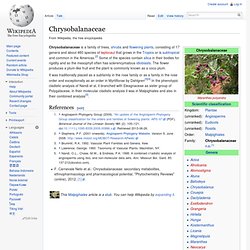

Chrysobalanaceae. Chrysobalanaceae. [edit] Classification System: APG III (down to family level) Main Page Regnum: Plantae Cladus: Angiosperms Cladus: Eudicots Cladus: Core eudicots Cladus: Rosids Cladus: Eurosids I Ordo: Malpighiales Familia: Chrysobalanaceae Genera: Acioa – Afrolicania – Atuna – Bafodeya – Chrysobalanus – Couepia – Dactyladenia – Exellodendron – Grangeria – Hirtella – Hunga – Kostermanthus – Licania – Magnistipula – Maranthes – Neocarya – Parastemon – Parinari Name[edit] Chrysobalanaceae R.Br.

Reference[edit] Chrysobalanaceae. Chrysobalanaceae is a family of trees, shrubs and flowering plants, consisting of 17 genera and about 460 species of leptocaul that grows in the Tropics or is subtropical and common in the Americas.[2] Some of the species contain silica in their bodies for rigidity and so the mesophyll often has sclerencymatous idioblasts.

The flower produces a plum-like fruit and the plant is commonly known as a coco plum. It was traditionally placed as a subfamily in the rose family or as a family in the rose order and exceptionally as an order in Myrtiflorae by Dahlgren[3][4] In the phenotypic cladistic analysis of Nandi et al, it branched with Eleagnaceae as sister group of Polygalaceae, in their molecular cladistic analysis it was in Malpighiales and also in their combined analysis[5].